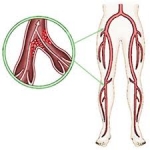White support hose following surgery can be a serious drag. They’re tight, hot and just plain uncomfortable. The doctors and nurses say they’re important, but why? Could they really save your life? Well, actually, yes. They can. A DVT, or otherwise known as a blood clot, can be the matter of life and death.

What is a blood clot?
A blood clot is when blood cells start to stick together or coagulate. When you cut yourself and draw blood, your body’s response is to clot or to coagulate to stop the bleeding. This is a normal response.
Deep vein thrombosis (DVT) is when the blood flow in your veins slow down and coagulates. These type of clots can be very dangerous and even life threatening.
“If a blood clot breaks free, it may travel through the bloodstream and block blood flow to the lungs.” -AAOS
A DVT can occur in many different ways, but the most common is after an injury or following surgery to the lower extremities. This is why patients are frequently required to wear TED hose to help prevent a blood clot from forming following a surgical procedure.

Warning Signs of Blood Clot:
- Pain in your calf and leg, unrelated to your incision
- Tenderness or redness about or below your knee.
- Swelling of your thigh, calf, ankle, or foot.
(Preventing Blood Clots After Orthopaedic Surgery)
If you think you may have any of the following symptoms, call your physician. A venous doppler (ultrasound of the veins) will likely be ordered. This test is an ultrasound on your legs to check for a blood clot.
If a blood clot is left untreated there is a risk of the clot breaking free and reaching to the lungs, blocking blood flow to the lungs and heart.
Warning Signs of Pulmonary Embolism:
- Sudden shortness of breath.
- Chest pain, particularly with breathing.
How does one prevent a DVT?
- After surgery, it’s good to begin walking or doing other leg exercises as soon as possible to help increase blood flow through the veins.
- Compression dressing or stockings- These prevent blood from pooling in the veins.
- Anticoagulants or otherwise known and blood thinning medication.
By: Stephanie Jones
Sources:
http://orthoinfo.aaos.org/topic.cfm?topic=a00219
http://orthoinfo.aaos.org/topic.cfm?topic=AV0009&webid=26DBE25F

